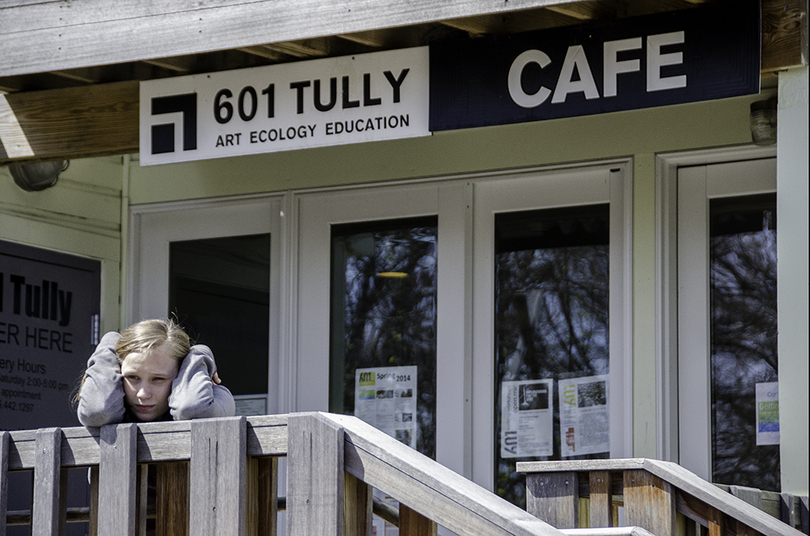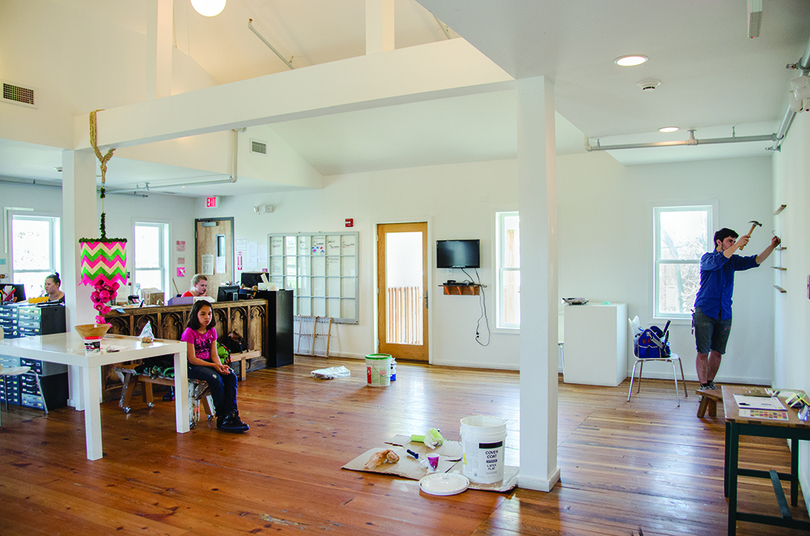In flux: Decrease in money leaves 601 Tully’s future uncertain
Founded partly to be a pillar of stability and consistency in an area of the city governed by uncertainty and change, the future of a Syracuse University-run arts center on the Near Westside — now, too — is in flux.
601 Tully, which was part of then-SU Chancellor Nancy Cantor’s vision of uniting the university with the city of Syracuse, will receive $200,000 less than its director anticipated for the center’s 2014–15 budget.
The “last-minute decision” would eliminate two salaried positions, said Marion Wilson, director of 601 Tully and an associate professor of arts education. That means programs students and community members depend on — including a summer camp for area youth — are in limbo.
“I think what’s really important, has always been important to me, is just to show up every day. To not change. To not be the thing that’s unstable in this neighborhood’s life,” Wilson said. “Because with these kids, everything else is unstable. So the one thing that we could do, no matter how imperfect we look, we would just show up every day.”
Cash-strapped
That stability was threatened earlier this month when Interim School of Education Dean Joanna Masingila informed Wilson that money for the two salaried positions would not be included in Chancellor Kent Syverud’s budget for next year. Wilson said this was the first time she heard about the cuts.
“I was stunned,” Wilson said. “I mean, I just had no warning. I called all the people I could to talk to them and say what happened.”
Vice Chancellor and Provost Eric Spina made the decision after consulting with Masingila and Ann Clarke, dean of the College of Visual and Performing Arts.
For the 2013–14 academic year, Wilson was given $200,000 to run the center — compared to $48,000 in previous years. In summer 2013, 601 Tully filled the two positions after a national search attracted 137 applicants. Jillian Nakornthap was hired as the center’s arts curator and Melissa Gardiner was hired as the coordinator of public programs. Both declined to be interviewed for this story.
Those positions will be eliminated May 15 if the center does not find more funding or negotiate a different agreement with the university.
The combined salaries for the positions totaled $77,000. The remaining money from the $200,000 budget went toward expenses such as full-time employee benefits, building maintenance and some of the programs held at the center, Wilson said.
Caught off-guard by what she considers a deep cut, Wilson has requested the budget be fully reinstated until the center’s lease expires. Had she been given notice, Wilson said she would have willingly scaled back costs.
But Masingila contended the $200,000 was a one-time sum awarded by Cantor for this year, she said. After the money was spent, the center would cover the salaries on its own through grants or other means moving forward.
Asked whether the money for salaried positions at 601 Tully was intended to be supported with one-time funding, Vice Chancellor and Provost Spina said in an email: “A number of projects in the Near West Side and as part of Professor Wilson’s previous courses have been supported by one-time, discretionary funds.”
He added: “Overall engagement activity in the city and community will continue to be valued when it advances faculty scholarship/research and supports student learning.”
The university will pay the two years remaining on the center’s lease. Wilson’s research budget will also be covered for the next three years, though it will decline annually.
The School of Education had to cut costs to address a budget deficit, which Masingila said is linked to a decline in both graduate student enrollment and grants awarded to faculty.
She declined to provide specific figures regarding the School of Education’s debt. But by the end of 2015, she said the school’s projected deficit will account for about 5 percent of its overall budget.
Excluding the salaries from the School of Education’s budget was not a performance-based decision. It was strictly done to cut costs, Masingila said. She added that 601 Tully was able to offer programming before the $200,000 was provided last summer.
“We saw a lot of benefits and a lot of value from being engaged in community arts,” she said. “But I think it’s just that decisions have to be made when you have a finite number of resources. What are you all going to support? And first priority has to be academic programs.”
A collaborative space
Students from the School of Architecture, VPA and the School of Education converted 601 Tully, a former drug haven, into a two-story community arts space across seven semesters.
The pastel colored building sits among rows of time-worn houses on the corner of Tully and Oswego streets on the city’s Near Westside. The center is a three-minute drive southwest of Armory Square.
On a recent afternoon, student-grown plants sat on a windowsill, basking in the warmth of the mid-afternoon sunlight. A bookshelf was crammed end to end with board games, picture books and boxes filled with craft supplies. Seated at a child-sized wooden stretch table, Wilson flipped through a booklet titled “Nature Matching System,” a color-coded curriculum that matches swatches with fruits and vegetables in an attempt to educate students on healthy eating.
Developing the booklet was, like most activities at 601 Tully, intended to be collaborative.
The campus and community collaboration allows for an exchange between different worlds, said Wilson, who teaches her courses from the building. Creative writing faculty members from SU have showed up for open mic nights, inhabiting the space alongside Syracuse City School District students. SU students volunteer through Hendricks Chapel to teach weekend nature classes to youth.
“By having college kids, having artists show up here every day in this neighborhood with respect and respectfully work here with the community members, that’s what changes people,” Wilson said. “Not only students, but a community.”
Hiring the two staff members last summer allowed the center to expand its programming, Wilson said. They coordinate themed art exhibitions, field trips, poetry open mic nights and an after school program. The elimination of funding for 601 Tully has jeopardized the future of those programs.
“Without staff, there is no programming,” she said.
An uncertain future
Despite the uncertainty 601 Tully faces, Wilson has been meeting with potential donors and is looking into making the center a nonprofit organization independent of SU. It simplifies the grant writing process, she said. 601 Tully has received a total of 14 grants in its history.
More than 30 letters addressed to Vice Chancellor Spina express support for the center and ask for the budget to be fully reinstated.
“I love 601 Tully greatly, and all the people who are so impacted by it would be at a great loss if 601 Tully ceases to exist,” wrote Samantha Harmon, a 2009 VPA graduate and former employee at the center.
“Without 601 Tully in my life while I attended high school, I would not have made it to college, much less to my senior year,” wrote Troy Hamlin, a current student at Daemen College who was exposed to the center as a sophomore at Fowler High School.
“The institution is at a moment of great potential as it gathers momentum and support from other initiatives in the neighborhood, and to withdraw support at this time would be a great waste of an extended effort from a large group of stakeholders,” wrote Andrew Weigland, a 2012 School of Architecture graduate who worked as a design assistant and volunteer with the center.
Wilson said she remains hopeful. On Monday, she received ‘potential support’ for the summer camp program. Initially, it was unclear if the camp, which hires SU students and attracts neighborhood youth, would open.
But with support from the community, she still has hope for 601 Tully.
Said Wilson: “We are embracing new partnerships as we move through this transition.”
Published on April 29, 2014 at 1:59 am
Contact Debbie: dbtruong@syr.edu | @debbietruong







